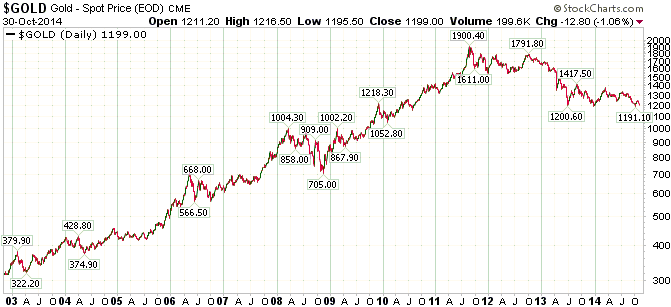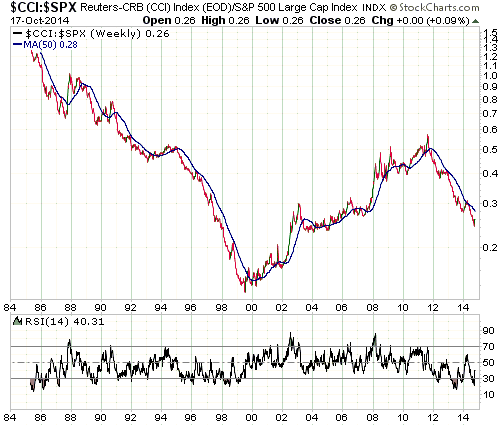This topic was recently revisited at TSI due to the growing popularity of ETFs that are designed to move each day by 2 or 3 times the amount of a target index. My main point was/is that leveraged ETFs should only ever be used as short-term trading vehicles, because they tend to leak value over time. This is not a design flaw; it’s just something that anyone who trades these ETFs should be well aware of. Here is a slightly modified version of the most recent TSI coverage of the issue.
The crux of the matter is that leveraged ETFs are designed to move by 2 or 3 times the DAILY percentage changes of the target indexes. They are NOT designed to move by 2 or 3 times the percentage change of the target indexes over periods of longer than one day. Due to the effects of compounding, their percentage changes over periods of much longer than one day will usually be less — and sometimes substantially less — than 2-times (in the case of a 2X ETF) or 3-times (in the case of a 3X ETF) the percentage changes in the target indexes. For example, if you believe that the S&P500 Index is going to fall by 30% over the coming 12 months and to profit from this expected decline you purchase SDS, an ETF designed to move each day by 2-times the inverse of the SPX’s percentage change, then you will probably not make a 60% profit on this trade even if you turn out to be totally correct about the SPX’s performance. Instead, the amount of profit you make will be determined by the path taken by the SPX on its way to the 30% loss and will probably be a lot less than 60%.
The easiest way for me to explain how the relationship between the daily percentage change of an index and the daily percentage change of an associated leveraged ETF does not translate into a similar relationship over periods of longer than one day, is via some hypothetical examples that show how the math works. Here I go.
In the tables presented below, Index A is the target index (the index for which leveraged exposure is created) and 100 is the starting (Day 0) value for both the index and the associated leveraged ETF. I then move the index up on one day and down by the same amount on the next day, such that by Day 6 it is still at 100.
In the first table, Index A alternately moves up by 10 points and down by 10 points, ending Day 6 back where it started (at 100). The final column in this table shows the value of an ETF designed to move each day by twice the percentage change of Index A. Even though Index A ended the 6-day period unchanged, the 2X ETF based on Index A ended the period with a loss of 5.4%.
| Index A $ Value | Index A $ change | Index A % change | 2X ETF % change | 2X ETF $ Value | |
| Day 0 | 100.0 | 0.0 | 0.0 | 0.0 | 100.0 |
| Day 1 | 110.0 | 10.0 | 10.0 | 20.0 | 120.0 |
| Day 2 | 100.0 | -10.0 | -9.1 | -18.2 | 98.2 |
| Day 3 | 110.0 | 10.0 | 10.0 | 20.0 | 117.8 |
| Day 4 | 100.0 | -10.0 | -9.1 | -18.2 | 96.4 |
| Day 5 | 110.0 | 10.0 | 10.0 | 20.0 | 115.7 |
| Day 6 | 100.0 | -10.0 | -9.1 | -18.2 | 94.6 |
In the second table the volatility is ramped up. Instead of Index A alternately moving up and down by 10 points it experiences 20-point daily swings, but still ends Day 6 back where it started (at 100). Even though Index A ended the 6-day period unchanged, in this case the 2X ETF based on Index A ended the period with a loss of 18.7%.
| Index A $ Value | Index A $ change | Index A % change | 2X ETF % change | 2X ETF $ Value | |
| Day 0 | 100.0 | 0.0 | 0.0 | 0.0 | 100.0 |
| Day 1 | 120.0 | 20.0 | 20.0 | 40.0 | 140.0 |
| Day 2 | 100.0 | -20.0 | -16.7 | -33.3 | 93.3 |
| Day 3 | 120.0 | 20.0 | 20.0 | 40.0 | 130.7 |
| Day 4 | 100.0 | -20.0 | -16.7 | -33.3 | 87.1 |
| Day 5 | 120.0 | 20.0 | 20.0 | 40.0 | 122.0 |
| Day 6 | 100.0 | -20.0 | -16.7 | -33.3 | 81.3 |
In the third and final table I go back to the 10-point daily swings, but change the leverage to 3-times. In this case, the unchanged result for the index was accompanied by a loss of 15.5% for the leveraged ETF.
| Index A $ Value | Index A $ change | Index A % change | 3X ETF % change | 3X ETF $ Value | |
| Day 0 | 100.0 | 0.0 | 0.0 | 0.0 | 100.0 |
| Day 1 | 110.0 | 10.0 | 10.0 | 30.0 | 130.0 |
| Day 2 | 100.0 | -10.0 | -9.1 | -27.3 | 94.5 |
| Day 3 | 110.0 | 10.0 | 10.0 | 30.0 | 122.9 |
| Day 4 | 100.0 | -10.0 | -9.1 | -27.3 | 89.4 |
| Day 5 | 110.0 | 10.0 | 10.0 | 30.0 | 116.2 |
| Day 6 | 100.0 | -10.0 | -9.1 | -27.3 | 84.5 |
An implication of the above is that the greater the volatility of an index and the greater the leverage provided by an ETF linked to the index, the worse the likely performance of the leveraged ETF over extended periods. The worse, that is, relative to the performance superficially implied by the daily percentage change relationship between the index and the leveraged ETF. So, it is fair to say that leveraged ETFs are only suitable for short-term trades and that a trade should be very short-term if it involves a 3X ETF and/or a volatile market.
My final point is that it is possible to take advantage of the value leakage inherent in the design of leveraged ETFs by shorting them rather than buying them. For example, if you want to use a leveraged ETF to profit from an expected decline in the S&P500 Index, you will generally be better served by going short SSO (ProShares Ultra Long S&P500 Fund) than by going long SDS (ProShares Ultra Short S&P500 Fund). For another example, if you want to use a leveraged ETF to profit from an expected rise in junior gold-mining stocks and you plan to hold the position for more than a few weeks, you will generally be better served by going short JDST (Junior Gold Miners Index Bear 3X) than by going long JNUG (Junior Gold Miners Index Bull 3X).
 Print This Post
Print This Post



